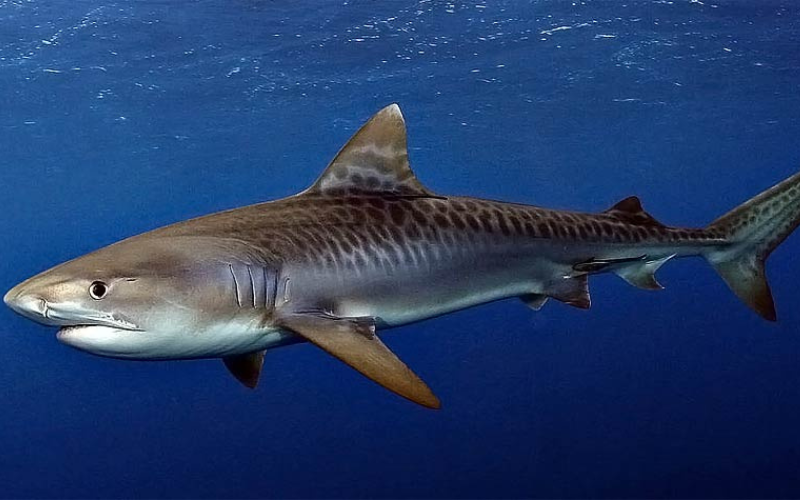Tiger Sharks: The Striped Predators of the Sea

Our divers, accompanied by the “shark
whisperer” Hamada, were recently lucky enough to spot one of the lesser-seen species
in the Red Sea, the Tiger Shark, on an outing to Jackson Reef.
As one of the most formidable
predators in the sea, Tiger Sharks are often misunderstood and unfairly treated,
but they are fascinating creatures that play a vital role in maintaining the
health of marine ecosystems.
What is it makes the Tiger Shark so
special?
1. Tiger Sharks
Are Big
Tiger Sharks are one of the largest sharks in
the world. Tiger sharks can grow quite large,
typically reaching lengths of 10 to 14 feet (3 to 4 meters), and can weigh up
to 1,400 pounds (635 kg). The largest on record was over 5m long and weighed ~635kg
They have a blunt, broad head with
large, powerful jaws lined with uniquely serrated teeth that can slice through
the toughest of prey. Unlike the more streamlined bodies of species like the
great white, tiger sharks are stockier and built for slow, stealthy movement
2. Tiger Sharks Are Stripey
Tiger sharks get their name from
the vertical, tiger-like stripes that run along the sides of their bodies.
These markings are most prominent in juveniles and tend to fade slightly as the
shark matures. The coloration helps provide camouflage in the water, breaking
up the outline of the shark and making it harder for prey to spot.
3. The “Garbage Cans”
of The Ocean
Tiger Sharks will eat almost anything! Feeding
on venomous sea snakes, clams, crabs, squid, fish, sharks, rays, turtles,
seals, dolphins, birds, carrion, and even litter! Bottles, paint cans, leather
jackets, license plates, car tyres have all been found in their stomachs. One
Tiger Shark, caught off the coast of Senegal, was found with a tom-tom, a
traditional Senegalese drum, in its stomach.
While this has earned them a
reputation as aggressive or dangerous, tiger sharks are simply doing what
evolution has designed them to do—take advantage of available food sources to
survive.
4. Tiger Sharks Make A Marine
Eco System Healthier
With such a varied diet, Tiger Sharks play a
key role in maintaining healthy marine ecosystems. By preying on the sick and
old, they prevent the spread of disease across a broad range of species. Their
mere presence also helps protect seagrass from overgrazing – a vital habitat
for many marine species.
5. Are Tiger Sharks
Dangerous To Divers?
No!
Tiger sharks are often portrayed in
the media as dangerous to humans, and they are one of the shark species most
commonly involved in unprovoked attacks. However, shark attacks are extremely rare, and fatalities are even rarer. In
reality, humans are a far greater threat to tiger sharks than they are to us.
Millions of sharks, including tiger
sharks, are killed each year by commercial fishing, bycatch, and shark finning.
See how you can help to stop the illegal trading of fins here Home - STOP FINNING EU https://stop-finning-eu.org/
6. Do Tiger Sharks
Travel In Groups?
Generally, no, they are solitary
creatures – you are lucky to spot one on a dive trip, let alone a large group!
The upcoming summer months when the water is warmer is a great time for
spotting sharks in the Red Sea, including the elusive Tiger shark.
Tiger Sharks are not completely antisocial
and they may feed with other sharks if large prey is available. Spending their
time in deeper waters during the day, they move closer to shore at night to
hunt.
Tiger Sharks will also come
together in large groups during mating season. In the Northern Hemisphere
mating takes place in spring. In the Southern Hemisphere during winter months.
7. Tiger Shark Pups Are
Born With Spots
The embryos of Tiger sharks develop
inside eggs that remain within the mother’s body until ready to hatch.
Typically a female will give birth to a litter of 10 to 80 pups, each measuring
about 20 – 30 inches long and with a distinctive grey spot marking.
These spots turn into the stripes
that give the Tiger Shark their name but fade as a shark gets older, in a fully
grown adult Tiger Shark the stripes can often be barely visible.
Tiger sharks grow slowly and can
live for 30 to 40 years in the wild. However, due to threats from human
activities, many do not reach their full lifespan.


